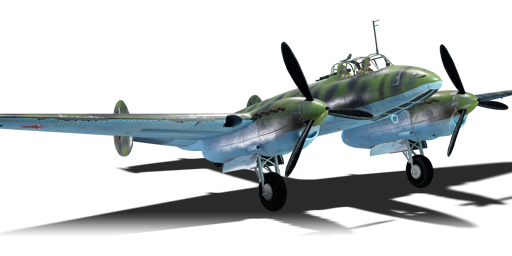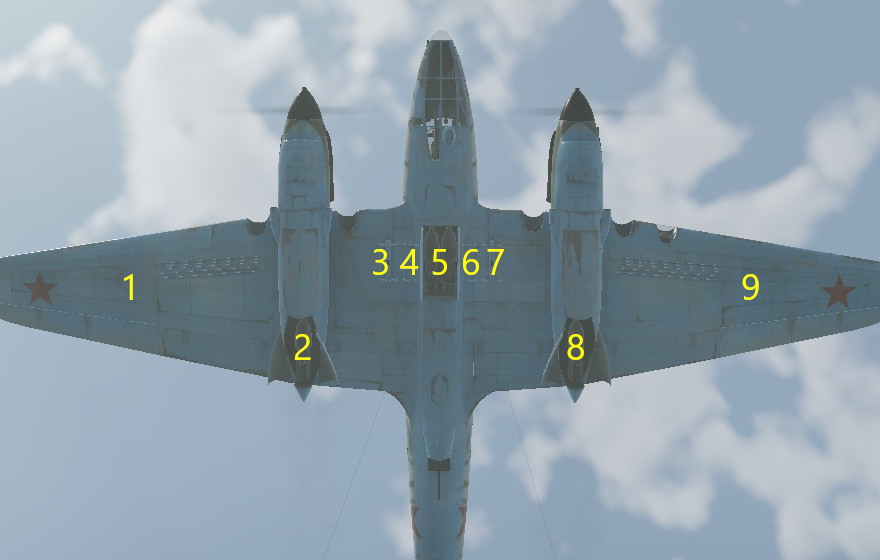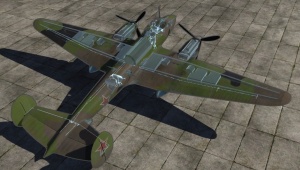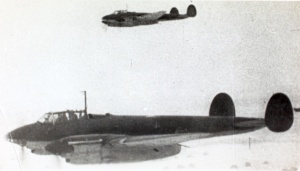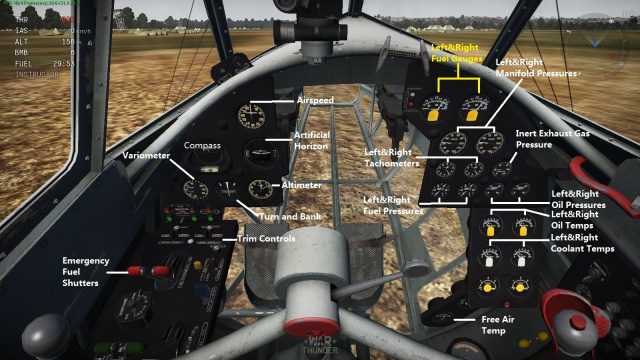Pe-2-359
| This page is about the Soviet dive bomber Pe-2-359. For other versions, see Pe-2 (Family). |
Contents
Description
The Pe-2-359 Peshka is a rank Soviet bomber with a battle rating of (AB), (RB), and (SB). It has been in the game since the start of the Open Beta Test prior to Update 1.27.
The Pe-2 fulfils much the same attack craft role as the IL-2. While the armament is a mix of MGs and therefore worse than the IL-2's, it can carry much heavier bombs, allowing it to destroy targets in one hit that a Sturmovik might take two or three bombs to destroy. Additionally, its nose-mounted weaponry, ability to mount rockets, and fact that it spawns at bomber altitude in Arcade make it a surprisingly effective bomber hunter in a pinch. However, as in other attack craft, you should have a friendly cover you whenever possible. While it has a decent amount of defensive guns and is faster than the Sturmovik, it is still very vulnerable when caught alone. Further, it is very vulnerable to diving attacks due to its dorsal-mounted fuel tank.
Performance-wise, the Pe-2-359's top speed is 552 km/h (343 mph) at an altitude of 3,700 m (12,139 ft) and 470 km/h (292 mph) at sea level. Reaching an altitude of 3,700 m takes 4 minutes and 37 seconds, a full horizontal turn at a speed of 500 km/h (310.7 mph) is completed in 18 seconds and a full loop at the same speed is completed in 20 seconds. Structural damage occurs around 790 km/h (540.6 mph) indicated airspeed (IAS).
The biggest advantages of the Pe-2-359 are its speed and manoeuvrability. In both departments, the Pe-2-359 is impressive. Both at altitude and at sea level, its speed is good for a twin-engine bomber, allowing you to either make low-altitude high-speed attack runs or to quickly get into position for dive attacks. It's also surprisingly agile for a bomber, as it can horizontally out turn most heavy fighters and even some less agile single-engine fighters. As to offensive capabilities, the aircraft is equipped both with a horizontal bombsight and airbrakes, so it can act both as a horizontal bomber and as a dive bomber against precision targets. Alternatively, ten RS-132 rockets can make the Pe-2-359 a formidable tank buster.
However, there are disadvantages as well. The fixed armament is inadequate at best. Two nose-mounted machine guns simply lack the punch of cannons and their low ammunition supply prevents prolonged usage. The defensive armament is not any better – the upper and lower hemisphere of the aircraft are each defended only by a single 12.7 mm machine gun, with the ventral turret having an extremely limited field of view and the side mounts being largely redundant. Your best defence is then the Pe-2-359's agility and speed. When attacked by enemy fighters, use your speed to run away and your agility to dodge gun passes.
Fast, agile and very versatile, the Pe-2-359 can be a great bomber if used correctly and its niche lays in tank battles, where it can utilize its rocket armament and dive bomber capabilities. Further research of this line will then lead you to larger and much better armed Tupolev Tu-2 bomber.
General info
Flight performance
Describe how the aircraft behaves in the air. Speed, manoeuvrability, acceleration and allowable loads - these are the most important characteristics of the vehicle.
| Characteristics | Max Speed (km/h at 3,700 m) |
Max altitude (metres) |
Turn time (seconds) |
Rate of climb (metres/second) |
Take-off run (metres) | |||
|---|---|---|---|---|---|---|---|---|
| AB | RB | AB | RB | AB | RB | |||
| Stock | 524 | 509 | 27.3 | 28.7 | 10.6 | 10.5 | 326 | |
| Upgraded | 555 | 540 | 24.8 | 26.0 | 15.1 | 12.8 | ||
Details
| Features | ||||
|---|---|---|---|---|
| Combat flaps | Take-off flaps | Landing flaps | Air brakes | Arrestor gear |
| ✓ | ✓ | ✓ | ✓ | X |
| Limits | ||||||
|---|---|---|---|---|---|---|
| Wings (km/h) | Gear (km/h) | Flaps (km/h) | Max Static G | |||
| Combat | Take-off | Landing | + | - | ||
| 508 | 477 | 320 | ~11 | ~6 | ||
| Optimal velocities (km/h) | |||
|---|---|---|---|
| Ailerons | Rudder | Elevators | Radiator |
| < 380 | < 380 | < 440 | > 250 |
Survivability and armour
- 8 mm Steel plate behind the pilot x 2
- 8 mm Steel plate in behind of dorsal gunner
- 8 mm Steel plate in the ventral turret (bottom)
- 8 mm Steel plate in the ventral turret (top/rear)
- No armour glazing
- Critical components located in front of aircraft (fuel, pilot, engine, controls)
- More fuel tanks located in wings near fuselage
Modifications and economy
- The first rank of upgrades are rather uninteresting. Take either two out of three to unlock research for Tier 2.
- DZ-40 first to unlock more payload variants. Afterwards, the only thing to worry about is performance. Acceleration takes a hit with the new heavier payloads.
Useful and in order of research are: Compressor, Engine, Wings repair, Engine Injection & Cover. The remaining upgrades can be chosen and upgraded in any order.
Armaments
Offensive armament
The Pe-2-359 is armed with:
- 1 x 12.7 mm Berezin UB machine gun, nose-mounted (150 rpg)
- 1 x 7.62 mm ShKAS machine gun, nose-mounted (450 rpg)
Suspended armament
The Pe-2-359 can be outfitted with the following ordnance:
| 1 | 2 | 3 | 4 | 5 | 6 | 7 | 8 | 9 | ||
|---|---|---|---|---|---|---|---|---|---|---|
| 100 kg FAB-100M-43 bombs | 1 | 1 | 1 | 4 | 1 | 1 | 1 | |||
| 250 kg FAB-250M-43 bombs | 1 | 1 | 1 | 1 | ||||||
| 250 kg BRAB-250 bombs | 1 | 1 | 1 | 1 | ||||||
| 500 kg FAB-500M-43 bombs | 1 | 1 | ||||||||
| 500 kg BRAB-500 bombs | 1 | 1 | ||||||||
| M-13UK rockets | 5 | 5 | ||||||||
| RBS-132 rockets | 5 | 5 | ||||||||
| Maximum permissible loadout weight: 1,050 kg | ||||||||||
| Default weapon presets | |
|---|---|
| |
Defensive armament
The Pe-2-359 is defended by:
- 1 x 12.7 mm Berezin UB machine gun, dorsal turret (200 rpg)
- 1 x 12.7 mm Berezin UB machine gun, ventral turret (200 rpg)
- 1 x 7.62 mm ShKAS machine gun, 2 x beam turret (225 rpg = 450 total)
Usage in battles
Its fixed armament consists of two nose-mounted machine guns – one 12.7 mm (0.5 in) UB machine gun with 150 rounds, and one 7.62 mm (0.3 in) ShKAS machine gun with 450 rounds. Another four machine guns are mounted as defensive armament. Two 12.7 mm UBT machine guns are mounted in dorsal and ventral turrets, and two ShKAS machine guns are mounted inside positions. The basic bomb load consists of six 100 kg (220 lb) carried internally in one central bomb bay and two smaller ordnance points at the rear of the engine nacelles. Through further progression, you can then unlock DZ-40 bomb racks, allowing you to carry three different ordnance configurations – either four 100 kg bombs internally and two 250 kg (551 lb) bombs externally, four 250 kg bombs externally, or two 500 kg (1102 lb) bombs externally. Alternatively, you can also unlock RO-132 rocket rails which will allow you to carry ten 132 mm (5.2") RS-132 rockets.
Most versatile and useful payload variant is the 2 x 250 kg + 4 x 100 kg option. Those dual outside mounted 250 kg bombs do NOT drop in pairs as usual (RB/SB effect). The same applies to 2 x 500 kg payload. Each one drops single upon pressing the release button. Beware though: The unlockable payload options take a big toll on climb rate, acceleration and speed. For a quick and speedy mission, the stock six times 100 kg bombs all mounted inside remains a very good choice.
The ten rockets payload is worth a look too. If compared to the highest quantity bomb loads with six single drops each. This option can engage four targets more in Arcade, but one less than in RB/SB as the rockets are fired in pairs. The RS-132 is derived from the Katyusha artillery and therefore quite potent. However, 100 kg of bombs are stronger in overall strength and depending on the terrain easier to deliver. Rockets however only require aim with the crosshair, allowing for an unobstructed view and a direct approach. Especially the former point is on often overlooked advantage. A third difference is the delivery time, rockets are just faster at the target. A big advantage versus moving targets. And they can double as anti-air armament, a department where the Pe-2s are severely lacking.
Manual Engine Control
| MEC elements | ||||||
|---|---|---|---|---|---|---|
| Mixer | Pitch | Radiator | Supercharger | Turbocharger | ||
| Oil | Water | Type | ||||
| Controllable | Controllable Not auto controlled |
Not controllable Not auto controlled |
Controllable Auto control available |
Separate | Controllable 2 gears |
Not controllable |
Pros and cons
Pros:
- Good manoeuvrability
- Decent speed
- Versatile payloads
- Nose-mounted weaponry
Cons:
- Large target
- Small ammunition pools
- Offensive armament is underwhelming
- Defensive armament is less-effective
- Large fuel tank in the midsection makes it vulnerable to fires.
History
Originally, the Petlyakov Pe-2 was not supposed to be a bomber at all. Its direct predecessor, designated VI-100, was designed by a prison design bureau team led by Vladimir Petlyakov as a high-altitude escort fighter. The VI-100 was very modern for its time, featuring a pressurized two-seat cockpit, electrically actuated systems and all-metal construction, and was powered by two supercharged Klimov M-105 V-12 inline engines producing 1,100 horsepower each. The prototype was completed in 1939 and during its first test flight on 7th May 1939, it reached a top speed of 627.6 km/h (390 mph) – an astounding performance for its time. The results of flight tests were so promising that the VI-100 was ordered into production.
However, Germany launched the "Blitzkrieg" campaign in September 1939. Aside from their revolutionary usage of tanks, the campaign in Poland featured notable usage of Ju 87 dive bombers and showed their potential. Consequently, the Soviet authorities ordered the VI-100 to be redesigned as a dive bomber. Pressurization equipment and engine superchargers were removed, dive brakes were installed under the wings and the bombardier position was added to the nose of the aircraft(raising the number of crew members to three). A ventral bomb bay was added along with the two smaller bomb positions located at the rear of engine nacelles. Two rear-facing turrets, each armed by a single ShKAS machine gun, were installed to dorsal and ventral positions. Resulting aircraft, able to carry up to 1,600 kg / 3,520 lbs of bombs, was designated PB-100. The first prototype flew on 15th December 1940 and its performance (top speed of 540.7 km/h / 336 mph) was so good that Vladimir Petlyakov was released and the aircraft was named after him, thus receiving the designation Petlyakov Pe-2. The bomber was then rushed into serial production and deliveries to combat units began in the spring of 1941. The deliveries were, however, slow and by the time of the German invasion in June 1941, only about 458 Pe-2's were delivered.
The Pe-2, nicknamed Peshka ("Pawn") by its crews, quickly proved itself to be an effective dive bomber and together with the Ilyushin Il-2 Sturmovik attacker, it became the most important offensive weapon of the Soviet Army Air Force. The bomber was fast and agile enough to be an elusive target for German fighters and also proved its versatility – it was used for reconnaissance and artillery spotting and also became the basis for the Pe-3 heavy fighter. Losses were heavy, however. Crews often complained about a lack of armour protection for the cockpit and fuel tanks as well as poor defensive armament and unreliable dive brakes, which sometimes failed to retract and allowed top speeds of only around 300 km/h (186.4 mph), making the fast bomber easy prey.
Based on these hard-earned experiences, the Pe-2 was being continuously improved over time. New, uprated Klimov M-105PF engines were installed producing 1210 horsepower each, and additional armour to the cockpit and fuel tanks were added. The defensive armament was improved by replacing dorsal and ventral ShKAS machine guns with 12.7 mm (.50 cal) UBT machine guns, and the fixed armament was modified to one ShkAS and one UB machine gun. The Pe-2 series 359 series, one of the latest variants of the Pe-2, then featured all of these modifications and could be distinguished from older series by individual exhaust pipes on the engines.
More than 11 000 Pe-2's were manufactured between 1941 and 1945 and were used on all fronts including Baltic sea, where Peshkas were used as naval bombers. Eventually, Pe-2's started to be supplanted and replaced by heavier and more advanced Tupolev Tu-2 bombers from 1942 onward and were definitely phased out of service after the arrival of the Ilyushin IL-28 jet bomber in 1950. It was also widely exported to various Warsaw Pact countries, where it was used until 1954.
| Archive of the in-game description | |
|---|---|
|
The final stage of mass production saw rather minor changes in the Pe-2's design. Beginning with series 359, all aircraft were equipped with individual exhaust pipes for the engines, and from series 382 on, a more powerful pneumatic starter was installed, changes were made to the sights, the oxygen system, the radio equipment, and other devices. In addition, minor aerodynamic improvements were made. Towards the very end of 1944, the last major change was introduced into the production Pe-2s: the wingtips were redesigned. The modified tips increased the Pe-2's maximum flight speeds and service ceiling and simultaneously improved its landing behavior. The Pe-2 was used on all fronts by the Air Force of the Workers' and Peasants' Red Army and also by naval aviation units from the beginning of World War II. It was employed as a dive bomber and as a photo reconnaissance aircraft. In early 1943, the Pe-2 drove the obsolete SB bombers out of regular military units, becoming the main and most widespread Soviet front line bomber. The Pe-2 reached its maximum potential under the control of Soviet flight crews, with whom it was a popular plane. It remained in service from the first day of the war to the last. Its last sortie in Europe was flown on May 8, 1945, towards the port of Liepaja. The Pe-2s also participated in a short military campaign in the Far East. During the war years, the Pe-2 was in service with Finland and Poland, as well as the USSR. Finnish Pe-2s, captured Soviet planes purchased from Germany, were used in Southern Karelia and against Leningrad, and they also participated in anti-submarine patrolling in the Baltics. The Polish bombers did not take part in any combat operations. The Pe-2's production was halted in December 1945. A total of 11,070 Pe-2's (including all variants) were produced from 1940 to 1945. None of the Soviet bombers were built in such numbers as the Pe-2, neither before nor after its production. After the war, the Pe-2 was in service with the USSR Air Force for several more years and were also shipped to the USSR's allies: Poland, Czechoslovakia, Bulgaria, Yugoslavia, and China. | |
Media
- Skins
- Images
See also
- Related development
- Aircraft of comparable role, configuration and era
External links
| V.M. Petlyakov Design Bureau (Опытное конструкторское бюро Петлякова) | |
|---|---|
| Fighters | Pe-3 (e) · Pe-3 · Pe-3bis |
| Bombers | Pe-2-1 · Pe-2-31 · Pe-2-83 · Pe-2-110 · Pe-2-205 · Pe-2-359 · Pe-8 |
| USSR bombers | |
|---|---|
| SB and Ar | SB 2M-100 · SB 2M-103 · SB 2M-103 MV-3 · SB 2M-103U · SB 2M-103U MV-3 · SB 2M-105 · Ar-2 |
| Yer-2 (petrol) | Yer-2 (M-105) · Yer-2 (M-105) TAT · Yer-2 (M-105R) TAT · Yer-2 (M-105R) LU |
| Yer-2 (diesel) | Yer-2 (ACh-30B) (e) · Yer-2 (ACh-30B) (l) |
| Tu | Tu-2 · Tu-2S · Tu-2S-44 · Tu-2S-59 · Tu-4 |
| Pe | Pe-2-1 · Pe-2-31 · Pe-2-83 · Pe-2-110 · Pe-2-205 · Pe-2-359 · Pe-8 |
| IL | DB-3B · IL-4 |
| Po | Po-2 · Po-2M |
| Other | MBR-2-M-34 · TB-3M-17-32 · Yak-4 · Be-6 |
| Lend-Lease | ▂PBY-5A Catalina · ▂Hampden TB Mk I · ▂A-20G-30 · ▂B-25J-30 |


